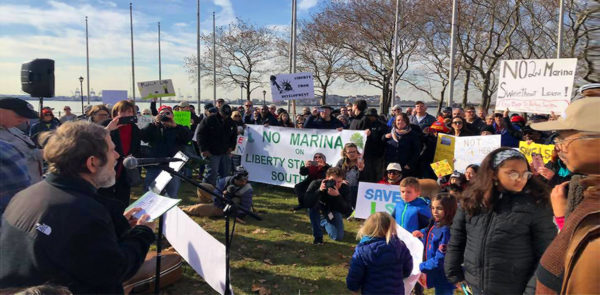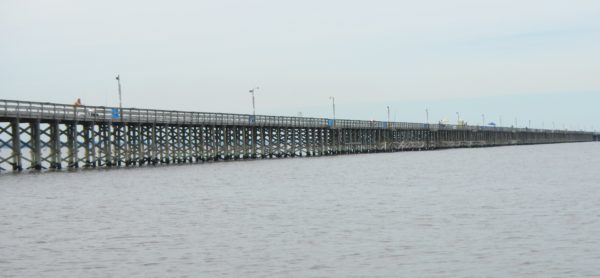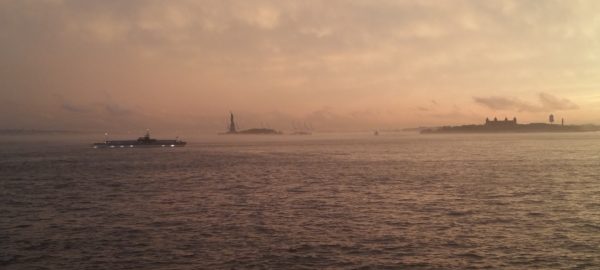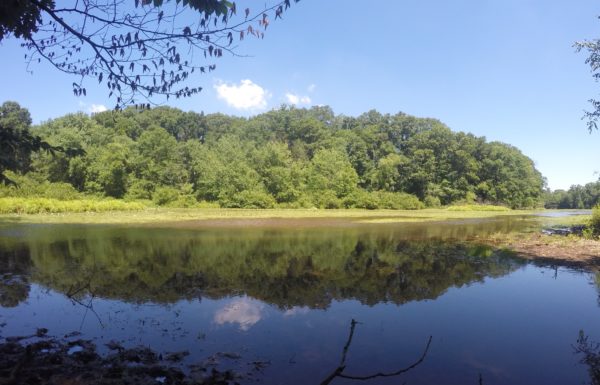History
NY/NJ Baykeeper was founded in 1989 by Andrew Willner, who had previously started a small boat building and repair yard on Staten Island. Willner’s daughter, who was 10 years old, visited the yard and it made Willner angry that she could not go swimming in the waters off Staten Island due to pollution. Willner saw firsthand the devastating effect the Exxon Bayway Oil Spill had on the Arthur Kill.
After Willner found out that there was a Riverkeeper on the Hudson River, a Soundkeeper in Long Island, and Baykeepers in Delaware and San Francisco. he began communicating with them and they helped him launch the Baykeeper program in the summer of 1989. Willner worked with NY/NJ Baykeeper for twenty years, until April 2008.
Today, we serve as the citizen advocate for the harbors, bays, streams, and shores of the NY-NJ Harbor Estuary by preserving and restoring habitat, influencing land use decisions, stopping polluters, championing public access, and educating the public.
To date NY/NJ Baykeeper has:
- Established the Safe Harbor Coalition in response to the 1990 Exxon/Arthur Kill oil spill, resulting in tens of millions of dollars in Natural Resource Damages recovery for the Estuary.
- Created the largest citizen water-quality monitoring program in the region, with more than 150 volunteers in New York City and northern New Jersey. This program built a tremendous interest in protection of the Estuary.
- Established the only on-water citizen patrol presence in the Raritan Bay, with staff and more than twenty Baykeeper Auxiliary volunteers patrolling for violations.
- Advocated successfully for the establishment of the Meadowlands Conservation Trust, a public-private land trust created through NJ legislation.

- Successfully advocated for the preservation of Liberty State Park, resulting in the defeat of several golf courses and water parks and privatization proposals. We established the Liberty State Park Conservancy to restore the interior of the park as forest, wetlands, and wildflower meadows.
- In 1999, worked in coalition with Newark, NJ, youth groups to restore sections of the Second River tributary to the Passaic and with local conservationists to preserve important floodplain land in the Third River tributary.
- Along with a cross-harbor coalition of grassroots organizations, including Save the Bay and NRPA of Staten Island, defeated a 2300 acre toxic mud island proposed by the Corps of Engineers for the most sensitive part of Raritan Bay.
- Created multi-language fish advisory in both New York and New Jersey brochures to be handed out at urban fishing sites , as well as distributing a video to women’s health clinics. This was in response to observations and reports of “subsistence” fishermen eating contaminated seafood from the harbor,

- An original participant in the Dredged Materials Management Work Group, and with Rutgers Environmental Law Clinic, Tri-State Transportation Campaign, and NRDC, guided efforts to limit channel deepening and establish “green port” principals. As a direct result, the Army Corps altered its Dredged Materials Management Plan recommendations.
- Along with NRDC, Coalition for the Bight, RPA and others, Baykeeper has successfully lobbied Congress and the States for millions of dollars for harbor habitat projects.
- Worked with the Port Authority to get $60 million to acquire critical habitats in New Jersey and New York City, which was based on the Harbor Estuary Program (HEP) critical habitat lists.
- Worked with the same coalition to get the Corps of Engineers to commit to a NY-NJ Harbor Estuary habitat restoration program resulting in the Comprehensive Restoration Project/HRE and a partnership of government and non-governmental organizations engaged in planning for large-scale wetlands, wet forest and habitat restoration projects.
- From 2015 – 2022, NY/NJ Baykeeper partnered with Monmouth County Health Department to provide free pumpouts to recreational boaters in the Shrewsbury and Navesink Rivers.

- NY/NJ Baykeeper is a member of the Harbor Roundtable, a group of government and NGO’s currently promoting habitat restoration. Our oyster restoration project was critical in getting consensus from this group that oysters and eel grass restoration should be the first project considered.
- Along with our partners (Natural Resources Defense Council, Environmental Defense, Rutgers University Environmental Law Clinic, Hackensack Riverkeeper, and Columbia University Environmental Law Clinic) NY/NJ Baykeeper began a process to establish a NY-NJ Harbor Estuary Conservancy , the principles of which continue to guide the identification and acquisition of urban habitats which were previously not considered viable by federal, state, county, municipal, or private land trusts. Baykeeper has facilitated the transfer of critical habitat areas from private to public owners throughout the urban part of the Estuary in New Jersey.

Legal History
- As a result of a legal settlement in a case brought by NYSDEC, Baykeeper and the American Littoral Society were able to establish a Jamaica Bay Guardian–a full time advocate to protect and preserve Jamaica Bay.
- As a result of a citizen suit under RCRA with NRDC and Hackensack Riverkeeper as partners, EPA ordered Occidental Chemical to increase the dioxin Superfund study area from the Passaic River to include the Newark Bay, Kill Van Kull, and Lower Hackensack River.
- In 2004 Baykeeper, NRDC and Green Faith brought a NEPA suit against the Corps of Engineers for failure to produce a supplementary EIS for dredging in a Superfund site, Newark Bay (see above). The Corps has agreed to do an Environmental Assessment. We believe that the outcome, which is imminent, will set a precedent for environmentally protective dredging in the Harbor and around the country.
- Through our “Clean Harbor Campaign,” Baykeeper brought legal action against combined sewer overflow (CSO) operators in violation of their permits. When we began this campaign, none were in compliance. At the end, all NJ CSO dischargers were in compliance with their general permit.
- NY/NJ Baykeeper’s 30-member “polluter pay” coalition to collect Natural Resource Damages from egregious polluters has resulted in stepped-up NJDEP efforts to bring dioxin polluter Occidental Chemical to justice. Baykeeper lobbied against bills in both states that would have limited the amount and types of Natural Resource Damage claims.
- In 2015, NY/NJ Baykeeper and Hackensack Riverkeeper successfully appealed NJDEP’s proposed Public Access Rule in 2015 to ensure greater public access to our waterways. This victory opened the door for NJ’s public access law, signed in 2019. Our Public Access campaign started with a lawsuit in which Baykeeper was a defendant intervener in a case brought by a national homebuilders organization testing the constitutionality of NJ’s Waterfront Development Act. The victory set a precedent for unfettered access to our urban waterfront. Ware defending the public’s right of access to NY City and New Jersey beaches, and have begun to make the case that pollution restricts access as much or more than fences on the water’s edge.
- As a result of a law suit brought against NYC DEP for violations of nitrogen limits, Long Island Soundkeeper and NY/NJ Baykeeper oversaw the distribution of more than $4 million for environmental benefit projects in Jamaica Bay, the East River and Long Island Sound.
Coastal Restoration History
- 2000 – Oyster Gardening program is launched at 25 sites.
- 2001-2004: 10,000 live oysters and bushels of shells were planted at Keyport Harbor and 100,000 live oysters added in 2002.
- 2002: Aquaculture program begins
- 2003-2005: Oyster Point Reef in Navesink River created: 32 cubic yard of clam shell forms ¼ acre reef in 2003; shell and 85,000 live oysters added in 2004 to expand reef to ½ acre.
- 2005: Natural spat found around Navesink River site showing oysters are reproducing on their own. Important observation: shows reef is on its way to being self-sustaining. Aquaculture facility for producing oysters built at Mobys in Highlands.
- 2008: NY Oyster Gardening Program was founded with the hiring of a NY coordinator
- 2010: The New Jersey Department of Environmental Protection’s (NJDEP) banned shellfish research, restoration, and education projects in “contaminated” waters; waters classified as “Restricted” or “Prohibited” for shellfish harvest. This essentially deems 99% of the NY-NJ Harbor off-limits for shellfish restoration. We were forced to remove our projects in Keyport Harbor and the Navesink River along Red Bank.
- 2011- 2012: In collaboration with CUES and ‘citizen-scientist’ volunteers a shoreline survey of Raritan Bay was conducted (pre-SuperStorm Sandy) from Sandy Hook, NJ to Great Kills Harbor in Staten Island, NY. Interactive maps generated from data collected.
- 2013: Baykeeper partners with Naval Weapons Station Earle and obtains a permit for 10.7 acres and an aquaculture facility is rebuilt.
- 2016: installation of the first Living Shoreline in NJ urban waters implemented with oyster castles seeded with oyster larvae.
- 2017 – 2022: Expansion of living shoreline with a total of 600 oyster castles. Biodiversity, sediment, and oyster growth/mortality research continues. Natural recruitment found at NWS Earle-first time natural recruitment has been seen at project site.
